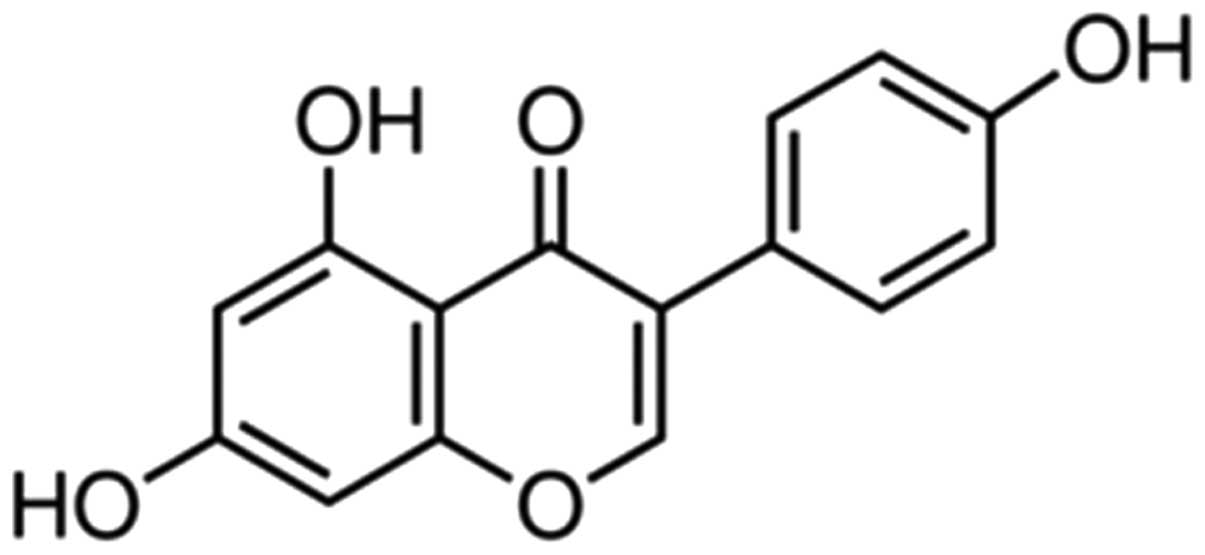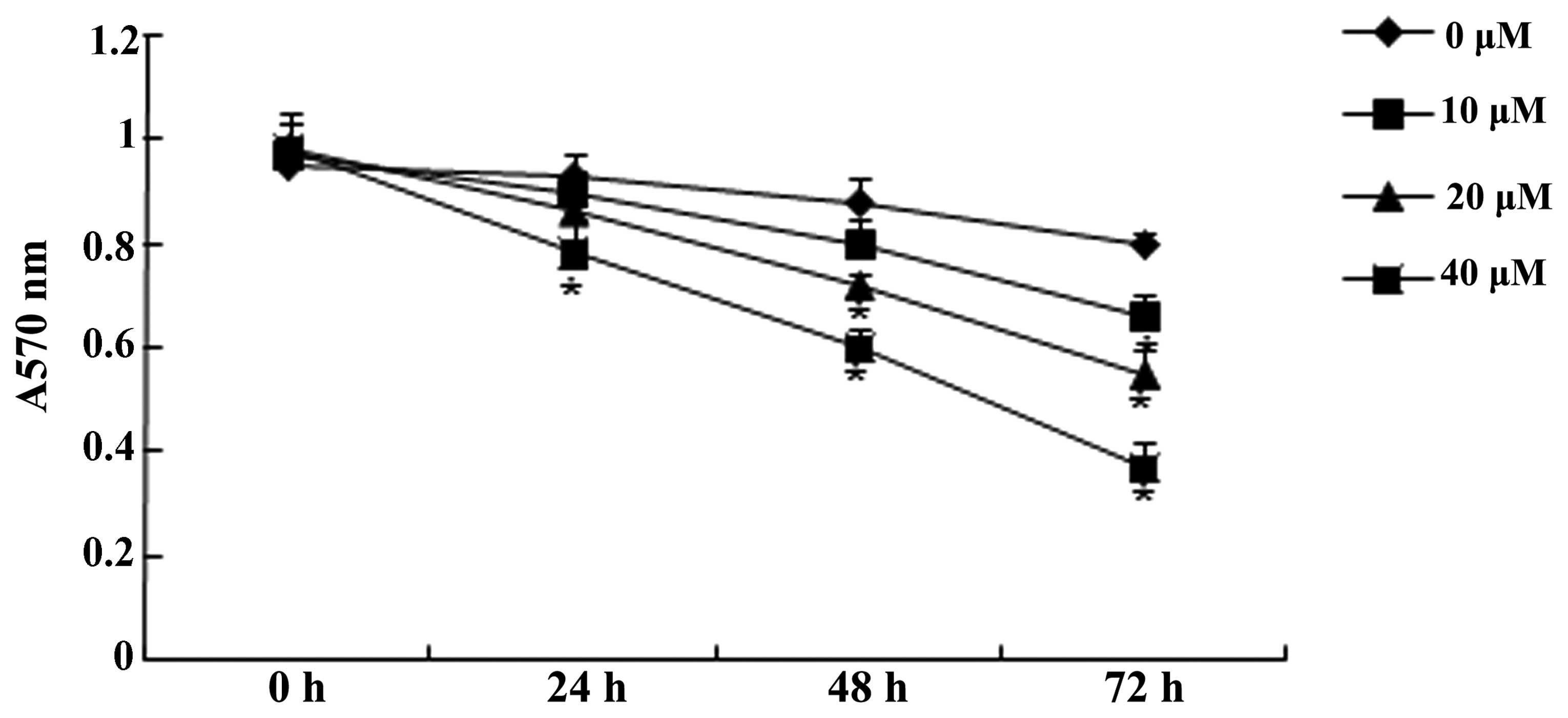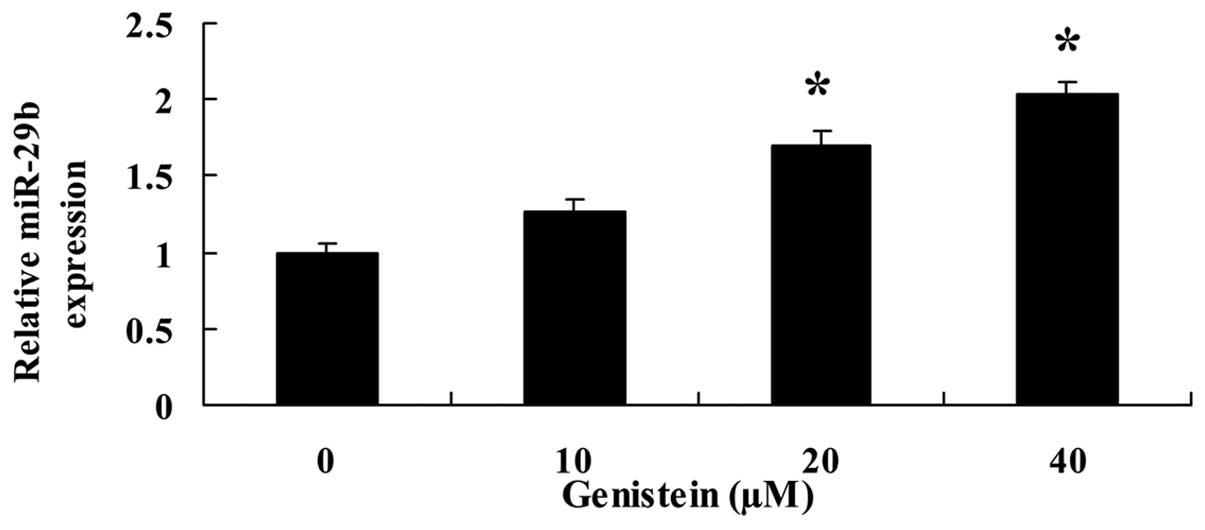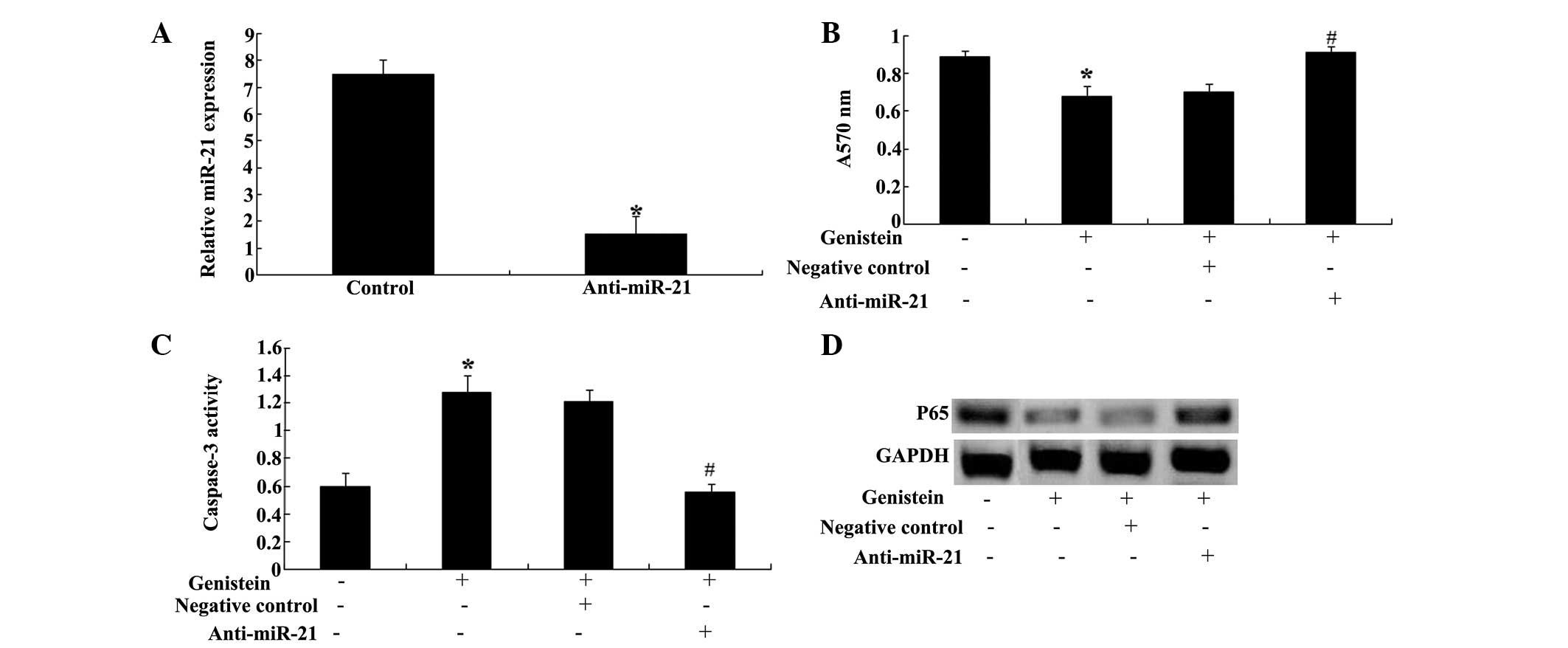Genistein inhibits the proliferation of human multiple myeloma cells through suppression of nuclear factor‑κB and upregulation of microRNA‑29b
- Authors:
- Published online on: December 30, 2015 https://doi.org/10.3892/mmr.2015.4740
- Pages: 1627-1632
Abstract
Introduction
Multiple myeloma (MM) is a malignant tumor, which originates from terminally differentiated B lymphocytes and is characterized by clonal proliferation of a large number of plasma cells in the bone marrow of patients. MM has a complex multi-step and multi-stage pathogenesis, and a variety of factors and pathways are involved in its development and progression (1,2). MM is the most common primary tumor of the bone marrow in the USA (3).
Previous studies have focused on the interactions among cytogenetic abnormalities, the bone marrow microenvironment, myeloma cells, nuclear factor-κB (NF-κB) signaling pathways and resistance mechanisms (4,5). The active transcription factor NF-κB is a heterodimer consisting of two subunits p50 and p65. Non-activated NF-κB in the heterodimer also inhibits IκB. Following activation, NF-κB changes into an active heterodimer, which then enters the nucleus and combines with the promoter region of several target genes. This triggers transcription of the target genes, thus increasing the expression of various cytokines, chemical factors, adhesion molecules and cyclin D, which in turn promotes the growth and survival of cells (6,7). Suppression of NF-κB enhances the anti-MM effects of conventional chemotherapeutic agents (5). For example, celastrol, an inhibitor of NF-κB, has been demonstrated to induce cell cycle arrest and apoptosis of human MM cells via downregulation of NF-κB (8).
MicroRNAs (miRs) are a type of non-coding small RNA with a length of ~22 nt, which regulate gene expression following transcription of genes, involved in the regulation of cell differentiation, apoptosis and proliferation by inhibiting the mRNA of specific target genes (9). Previous studies have demonstrated that miRNAs are extensively involved in the occurrence, development and prognosis of a tumor. For example, the expression of miR-29b was increased 10-fold in MM cells compared with in the plasma cells of healthy individuals (10). Upregulation of miR-29b has been demonstrated to induce significant antitumor activity in human MM (11). For example, Zhang et al (12) demonstrated that miRNA-29b-induced apoptosis was found to act antagonistically with IL-6 in human myeloma cell lines.
Genistein is predominantly found in Leguminosae, with the largest quantities identified in Fructus Sophorae and Subprostrate Sophora (13). Genistein is able to induce programmed cell death, increase the anti-cancer efficacy and inhibit angiogenesis, and thus is a promising cancer chemopreventive agent. The anticancer effect of genistein has broad application prospects (14,15) and thus requires further investigation. The aim of the present study was to examine the effects of genistein on the proliferation and apoptosis of human MM cells.
Materials and methods
Reagents and chemicals
The chemical structure of genistein is shown in Fig. 1. Genistein (Sigma-Aldrich, St. Louis, MO, USA; with a purity >98%) was dissolved in physiological saline according to the manufacturer's instructions (16,17). RPMI-1640 and fetal bovine serum (FBS) were purchased from Invitrogen Life Technologies (Carlsbad, CA, USA). The Caspase-3 Activity Assay kit and BCA protein assay kit were purchased from Shanghai Sangon Biotechnology Co., Ltd. (Shanghai, China). The Annexin V-fluorescein isothiocyanate (FITC)/propidium iodide (PI) Apoptosis Detection kit was purchased from BestBio (Shanghai, China). TRIzol reagent and quantitative polymerase chain reaction (qPCR) assays were purchased from Tiangen Biotech (Beijing) Co., Ltd. (Beijing, China).
Cell lines and cell culture
The human MM cell line U266 was purchased from the cell bank of the Chinese Academy of Sciences (Shanghai, China). The cells were maintained in RPMI-1640 culture medium supplemented with 10% FBS, 100 units/ml penicillin and 100 mg/ml streptomycin in a humidified atmosphere in a 37°C incubator with 5% CO2.
Cell viability assay
Cells were seeded (1×104 cells) in 96-well plates and treated with the indicated dose of genistein (0, 10, 20 and 40 µM) for 24, 48 and 72 h. Cell viability was measured using 3-(4,5-dimethylthiazol-2-yl)-2,5-diphenyltetrazolium bromide (MTT; Sigma-Aldrich). Absorbance was measured at λ=570 nm using a microplate reader (iMark™; Bio-Rad Laboratories, Inc., Hercules, CA, USA).
Annexin V-FITC/PI apoptosis assay
Cells were seeded (1×106 cells) in 6-well plates and treated with the indicated dose of genistein (0, 10, 20 and 40 µM) for 48 h. Briefly, apoptotic cells were measured using an Annexin V-FITC/PI Apoptosis Detection kit (BestBio). For flow cytometric analysis, a Cytomics FC500 flow cytometer with CXP software (Beckman Coulter, Fullerton, CA, USA) was used.
Caspase-3 activation assay
Cells were seeded (1×104 cells) in 96-well plates and treated with the indicated dose of genistein (0, 10, 20 and 40 µM) for 48 h. Briefly, caspase-3 activation was measured using the Caspase-3 Activity Assay kit (Shanghai Sangon Biotechnology Co., Ltd.). Protein cell lysate (10 µl per sample) was added to 80 µl reaction buffer with 10 µl substrate (Asp-Glu-Val-Asp-p-nitroanilide) and incubated at 37°C for 4–6 h. Caspase-3 activation was measured using a microplate reader (Bio-Rad Laboratories, Inc.) at an absorbance of 405 nm.
Western blotting
Cells were seeded (1×106 cells) in 6-well plates and treated with the indicated dose of genistein (0, 10, 20 and 40 µM) for 48 h. Protein concentration was determined using the BCA protein assay kit (Shanghai Sangon Biotechnology Co., Ltd.). Protein samples were analyzed using 12% SDS-polyacrylamide gel electrophoresis followed by semi-dry transfer onto a polyvinylidene fluoride membrane (Bio-Rad Laboratories, Inc.). The membrane was blocked with 5% non-fat milk in Tris-buffered saline and Tween-20 (TBST) buffer at 4°C for 4 h. The membrane was incubated with rabbit anti-human anti-NF-κB p65 (cat. no. BA0610-2; 1:500 dilution; Wuhan Boster Biological Technology, Ltd., Wuhan, China) and rabbit anti-human anti-GAPDH (cat. no. PB0141; 1:2,000 dilution; Wuhan Boster Biological Technology, Ltd.) overnight at 4°C. The membrane was washed with TBST and proteins were detected using a BCIP-NBT kit (Promega Corporation, Madison, WI, USA).
Reverse transcription (RT)-qPCR analysis of miR-29b expression
Cells were seeded (1×106 cells) in 6-well plates and treated with the indicated dose of genistein (0, 10, 20 and 40 µM) for 48 h. Total RNA was extracted from cells using TRIzol reagent [Tiangen Biotech (Beijing) Co., Ltd.] and miRNAs were specifically amplified for individual miRNA TaqMan qPCR analysis [Tiangen Biotech (Beijing) Co., Ltd.]. Quantification of the miRNAs was performed using TaqMan miRNA qPCR assays [Tiangen Biotech (Beijing) Co., Ltd.]. The primers used were as follows: Forward, 5′-GGG GGTACCCTTCAGGAAGCTGGTTTC-3′ and reverse, 5′-GGGGATATCTACATGTGAGGCAGGTTCTCAC-3′ for miR-29b; forward, 5′-CGCTTCGGCAGCACATATACTA-3′ and reverse 5′-CGCTTCACGAATTTGCGTGTCA-3′ for U6.
Transfection of miR-29b and anti-miR-29b
miR-29b and anti-miR-29b plasmids were designed and purchased from Shanghai Sangon Biotechnology Co., Ltd. When the U266 cells reached 70–80% confluence, Lipofectamine 2000 (Invitrogen Life Technologies) was used to transfect miR-29b (100 nmol/l) or anti-miR-29b (100 nmol/l) into U266 cells according to the manufacturer's instructions. Cells were seeded (1×106 cells) in 6-well plates and treated with the indicated dose of genistein (20 µM) for 48 h.
Statistical analysis
All experiments were repeated at least three times and were analyzed using SPSS statistical software version 18 (SPSS, Inc., Chicago, IL. USA). Comparisons between mean values were assessed using Student's unpaired t-test. P<0.05 was considered to indicate a statistically significant difference.
Results
MTT analysis for cell viability
The effect of genistein (0, 10, 20 and 40 µM) on U266 cell viability was examined by the MTT assay. The results demonstrated that Genistein could inhibit the proliferation of U266 cells. Following treatment with 10 µM genistein for 72 h, 20 µM genistein for 48 and 72 h and 40 µM genistein for 24, 48 and 72 h, the proliferation of U266 cells was significantly reduced compared with that of the group treated with 0 µM genistein (Fig. 2). Thus, 20 µM genistein was selected as the standard treatment for further experiments.
Flow cytometric analysis of cell apoptosis and measurement of caspase-3 activity
In order to further assess the effect of genistein (0, 10, 20 and 40 µM) on the apoptosis of U266 cells, apoptosis and the activity of caspase-3 were analyzed. Following treatment with genistein (0, 10, 20 and 40 µM) for 48 h, apoptosis of U266 cells increased in a concentration-dependent manner (Fig. 3A and B). Apoptosis of U266 cells was significantly increased following treatment with genistein (20 and 40 µM) for 48 h (Fig. 3A and B). In addition, following treatment with genistein (20 and 40 µM) for 48 h, the activity of caspase-3 in U266 cells was significantly increased, compared with that of the group treated with 0 µM genistein (Fig. 3C).
Inhibition of NF-κB by genistein
Based on the abovementioned results, western blotting was used to analyze the protein level of NF-κB in U266 cells (Fig. 4A). Notably, treatment with genistein (0, 10, 20 and 40 µM) for 48 h had a pronounced inhibitory effect on the protein level of NF-κB in U266 cells (Fig. 4B).
Genistein activates miR-29b expression
To further investigate the effect of genistein on miR-29b expression, qPCR was used to examine the expression of miR-29b in U266 cells. Following treatment with genistein (20 and 40 µM) for 48 h, the expression of miR-29b in U266 cells was significantly promoted (Fig. 5).
Overexpression of miR-29b and NF-κB expression
To improve our understanding of the expression of miR-29b and NF-κB in U266 cells, miR-29b was transfected into U266 cells and the expression of NF-κB in U266 cells was detected. These data indicated that transfection of miR-29b plasmids significantly increased the expression of miR-29b in U266 cells (Fig. 6A). Furthermore, overexpression of miR-29b significantly inhibited NF-κB expression in U266 cells (Fig. 6B).
Anti-miR-29b reverses the effect of genistein
To further investigate the correlation between the expression of miR-29b and the effect of genistein, the effect of genistein on MM was examined. The results demonstrated that transfection of anti-miR-29b plasmids into U266 cells significantly reduced the expression of miR-29b in U266 cells (Fig. 7A). Furthermore, anti-miR-29b plasmids could significantly reduce the effect of genistein on cell proliferation (Fig. 7B) and apoptosis of U266 cells (Fig. 7C). In addition, anti-miR-29b plasmids could promote the levels of NF-κB in U266 cells (Fig. 7D).
Discussion
MM is a malignant disease of plasma cells, of which the main clinical manifestations include hyperglobulinemia, renal dysfunction, bone damage and pancytopenia (18). At present there is no cure, however, there has been significant progress in treatment in previous years, including thalidomide, proteasome inhibitors and the application of bone marrow transplantation. However, the survival time of MM patients has not yet significantly improved. Therefore, possible treatments for MM are being continuously investigated. In the present study, genistein (5, 10 and 20 µM) inhibited the proliferation of U266 cells. Genistein possesses estrogen and anti-estrogen properties, as well as exerting antioxidant effects to inhibit the activity of protein tyrosine kinase, which inhibits the activity of topoisomerase II (19). In the present study, genistein significantly increased apoptosis and activity of caspase-3 in U266 cells. A previous study revealed that genistein combined with doxorubicin had a synergistic cytotoxic effect on breast cancer cells (20). Genistein has also been demonstrated to induce apoptosis of MCF-7 and 3T3-L1 cells via regulation of ERα expression (15).
Sustained activation of NF-κB can promote MM cell proliferation, mediate the secretion of IL-6 and the expression of adhesion molecules, upregulate anti-apoptotic proteins, inhibit death receptor pathways and promote angiogenesis, contributing to the proliferation of malignant myeloma cells and their resistance to apoptosis (21). Drugs targeting NF-κB can prevent NF-κB activation, promote apoptosis and improve prognosis, providing a broad prospect for the treatment of MM (22). In the present study, genistein was found to have a pronounced inhibitory effect on the protein level of NF-κB in U266 cells. In addition, Luo et al reported that genistein could induce apoptosis in human colon cancer through inhibiting the NF-κB pathway (23). Chung et al demonstrated that genistein inhibits phorbol ester-induced NF-κB transcriptional activity in human mammary epithelial cells (24).
miRNAs comprise ~1–2% of the known eukaryotic genome and are important in tumor biology, acting as tumor suppressor genes and proto-oncogenes. Overexpression of miRNA-29b reduces the level of Mcl-1 protein, thereby inhibiting the growth of MM cells, suggesting that miRNA-29b may be a tumor suppressor gene. Furthermore, miR-29b suppresses MM and endothelial cells by inducing the expression of SOCS-1 (25). Based on this, the present study found that the expression of miR-29b in U266 cells was also significantly promoted following treatment with genistein. It has been reported that genistein exerts its anti-tumor effect through downregulation of miR-1260b in prostate cancer cells (26). Xia et al reported that genistein can suppress pancreatic cancer cells through inhibition of miR-27a (27). The results of the present study demonstrated that overexpression of miR-29b significantly inhibited NF-κB expression in U266 cells. miR-29b was able to alter and control the expression of NF-κB in U266 cells. The decreased expression of miR-29b reduced the effect of genistein on U266 cells and increased the expression of NF-κB in U266 cells. In conclusion, genistein inhibits the proliferation and induces the apoptosis of human MM cells through suppressing NF-κB via upregulation of miR-29b.
References
|
Kelly T, Børset M, Abe E, Gaddy-Kurten D and Sanderson RD: Matrix metalloproteinases in multiple myeloma. Leuk Lymphoma. 37:273–281. 2000.PubMed/NCBI | |
|
Barillé S, Akhoundi C, Collette M, Mellerin MP, Rapp MJ, Harousseau JL, Bataille R and Amiot M: Metalloproteinases in multiple myeloma: Production of matrix metalloproteinase-9 (MMP-9), activation of proMMP-2 and induction of MMP-1 by myeloma cells. Blood. 90:1649–1655. 1997. | |
|
He X, Yang K, Chen P, Liu B, Zhang Y, Wang F, Guo Z, Liu X, Lou J and Chen H: Arsenic trioxide-based therapy in relapsed/refractory multiple myeloma patients: A meta-analysis and systematic review. Onco Targets Ther. 7:1593–1599. 2014. View Article : Google Scholar : PubMed/NCBI | |
|
Hameed A, Brady JJ, Dowling P, Clynes M and O'Gorman P: Bone disease in multiple myeloma: Pathophysiology and management. Cancer Growth Metastasis. 7:33–42. 2014. View Article : Google Scholar : PubMed/NCBI | |
|
Fuchs O: Targeting of NF-kappaB signaling pathway, other signaling pathways and epigenetics in therapy of multiple myeloma. Cardiovasc Hematol Disord Drug Targets. 13:16–34. 2013. View Article : Google Scholar : PubMed/NCBI | |
|
Manni S, Brancalion A, Mandato E, Tubi LQ, Colpo A, Pizzi M, Cappellesso R, Zaffino F, Di Maggio SA, Cabrelle A, et al: Protein kinase CK2 inhibition down modulates the NF-κB and STAT3 survival pathways, enhances the cellular proteotoxic stress and synergistically boosts the cytotoxic effect of bortezomib on multiple myeloma and mantle cell lymphoma cells. PLoS One. 8:e752802013. View Article : Google Scholar | |
|
Gatt ME, Takada K, Mani M, Lerner M, Pick M, Hideshima T, Carrasco DE, Protopopov A, Ivanova E, Sangfelt O, et al: TRIM13 (RFP2) downregulation decreases tumour cell growth in multiple myeloma through inhibition of NF Kappa B pathway and proteasome activity. Br J Haematol. 162:210–220. 2013. View Article : Google Scholar : PubMed/NCBI | |
|
Ni H, Zhao W, Kong X, Li H and Ouyang J: NF-kappa B modulation is involved in celastrol induced human multiple myeloma cell apoptosis. PLoS One. 9:e958462014. View Article : Google Scholar : PubMed/NCBI | |
|
Zhou JJ, Zheng S, Sun LF and Zheng L: MicroRNA regulation network in colorectal cancer metastasis. World J Biol Chem. 5:301–307. 2014. View Article : Google Scholar : PubMed/NCBI | |
|
Luo X, Gu J, Zhu R, Feng M, Zhu X, Li Y and Fei J: Integrative analysis of differential miRNA and functional study of miR-21 by seed-targeting inhibition in multiple myeloma cells in response to berberine. BMC Syst Biol. 8:822014. View Article : Google Scholar : PubMed/NCBI | |
|
Jagannathan S, Vad N, Vallabhapurapu S, Vallabhapurapu S, Anderson KC and Driscoll JJ: MiR-29b replacement inhibits proteasomes and disrupts aggresome+autophagosome formation to enhance the anti-myeloma benefit of bortezomib. Leukemia. 29:727–738. 2015. View Article : Google Scholar : | |
|
Zhang YK, Wang H, Leng Y, Li ZL, Yang YF, Xiao FJ, Li QF, Chen XQ and Wang LS: Overexpression of microRNA-29b induces apoptosis of multiple myeloma cells through down regulating Mcl-1. Biochem Biophys Res Commun. 414:233–239. 2011. View Article : Google Scholar : PubMed/NCBI | |
|
Qian K, Gao AJ, Zhu MY, Shao HX, Jin WJ, Ye JQ and Qin AJ: Genistein inhibits the replication of avian leucosis virus subgroup J in DF-1 cells. Virus Res. 192:114–120. 2014. View Article : Google Scholar : PubMed/NCBI | |
|
Suzuki R, Kang Y, Li X, Roife D, Zhang R and Fleming JB: Genistein potentiates the antitumor effect of 5-Fluorouracil by inducing apoptosis and autophagy in human pancreatic cancer cells. Anticancer Res. 34:4685–4692. 2014.PubMed/NCBI | |
|
Choi EJ, Jung JY and Kim GH: Genistein inhibits the proliferation and differentiation of MCF-7 and 3T3-L1 cells via the regulation of ERα expression and induction of apoptosis. Exp Ther Med. 8:454–458. 2014.PubMed/NCBI | |
|
Li J, Li J, Yue Y, Hu Y, Cheng W, Liu R, Pan X and Zhang P: Genistein suppresses tumor necrosis factor α-induced inflammation via modulating reactive oxygen species/Akt/nuclear factor κB and adenosine monophosphate-activated protein kinase signal pathways in human synoviocyte MH7A cells. Drug Des Devel Ther. 8:315–323. 2014. View Article : Google Scholar | |
|
Jamadar-Shroff V, Papich MG and Suter SE: Soy-derived isoflavones inhibit the growth of canine lymphoid cell lines. Clin Cancer Res. 15:1269–1276. 2009. View Article : Google Scholar : PubMed/NCBI | |
|
Chen HF, Li ZY, Tang JQ, Shen HS, Cui QY, Ren YY, Qin LM, Jin LJ, Zhu JJ, Wang J, et al: Clinical study of thalidomide combined with dexamethasone for the treatment of elderly patients with newly diagnosed multiple myeloma. Asian Pac J Cancer Prev. 13:4777–4781. 2012. View Article : Google Scholar : PubMed/NCBI | |
|
Nakamura H and Wang Y, Xue H, Romanish MT, Mager DL, Helgason CD and Wang Y: Genistein versus ICI 182, 780: An ally or enemy in metastatic progression of prostate cancer. Prostate. 73:1747–1760. 2013. View Article : Google Scholar : PubMed/NCBI | |
|
Xue JP, Wang G, Zhao ZB, Wang Q and Shi Y: Synergistic cytotoxic effect of genistein and doxorubicin on drug-resistant human breast cancer MCF-7/Adr cells. Oncol Rep. 32:1647–1653. 2014.PubMed/NCBI | |
|
Zhang GJ and Zhang Z: Effect of Bcl-2 on apoptosis and transcription factor NF-κB activation induced by adriamycin in bladder carcinoma BIU87 cells. Asian Pac J Cancer Prev. 14:2387–2391. 2013. View Article : Google Scholar | |
|
Li Z, Yang Z, Peng X, Li Y, Liu Q and Chen J: Nuclear factor-κB is involved in the protocadherin-10-mediated pro-apoptotic effect in multiple myeloma. Mol Med Rep. 10:832–838. 2014.PubMed/NCBI | |
|
Luo Y, Wang SX, Zhou ZQ, Wang Z, Zhang YG, Zhang Y and Zhao P: Apoptotic effect of genistein on human colon cancer cells via inhibiting the nuclear factor-kappa B (NF-κB) pathway. Tumour Biol. 35:11483–11488. 2014. View Article : Google Scholar : PubMed/NCBI | |
|
Chung MH, Kim DH, Na HK, Kim JH, Kim HN, Haegeman G and Surh YJ: Genistein inhibits phorbol ester-induced NF-κB transcriptional activity and COX-2 expression by blocking the phosphorylation of p65/Rel in human mammary epithelial cells. Mutat Res. 768:74–83. 2014. View Article : Google Scholar : PubMed/NCBI | |
|
Amodio N, Bellizzi D, Leotta M, Raimondi L, Biamonte L, D'Aquila P, Di Martino MT, Calimeri T, Rossi M, Lionetti M, et al: miR-29b induces SOCS-1 expression by promoter demethylation and negatively regulates migration of multiple myeloma and endothelial cells. Cell Cycle. 12:3650–3662. 2013. View Article : Google Scholar : PubMed/NCBI | |
|
Hirata H, Hinoda Y, Shahryari V, Deng G, Tanaka Y, Tabatabai ZL and Dahiya R: Genistein downregulates onco-miR-1260b and upregulates sFRP1 and Smad4 via demethylation and histone modification in prostate cancer cells. Br J Cancer. 110:1645–1654. 2014. View Article : Google Scholar : PubMed/NCBI | |
|
Xia J, Cheng L, Mei C, Ma J, Shi Y, Zeng F and Wang Z and Wang Z: Genistein inhibits cell growth and invasion through regulation of miR-27a in pancreatic cancer cells. Curr Pharm Des. 20:5348–5353. 2014. View Article : Google Scholar : PubMed/NCBI |
















